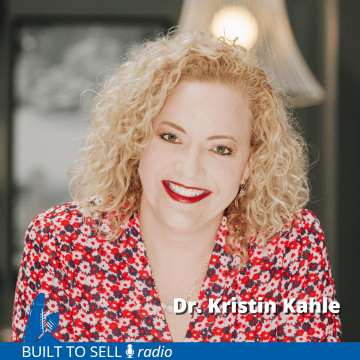About this episode
Dr. Kristin Kahle helps businesses pick a benefits program for their employees.
She started three insurance agencies and the first two were service businesses that sold for a modest 1.5-2 times EBITDA.
With her third business, Kahle wanted to attract a higher multiple, so she decided to transform it into a technology company. Kahle built NavigateHCR up to more than 40 employees before she decided to sell. She got three offers and ended up agreeing to be acquired for around 8 x EBITDA plus a five-year contract that guarantees her employment.
Here’s what you’ll learn from Kahle’s story:
- Why five years may be the ideal time to own a business.
- The $300,000 mistake Kahle made in trying to transition a service company into a technology business.
- How to massage your books to jack up your EBITDA and maximize the value you take from your sale.
- Why having something propriety nobody else offers matters to both your customers and potential acquirers.
- The value of long-term contracts.
- How to start an acquisition conversation with an acquirer through the person responsible for partnerships.
- A unique way to carve out time to work on your M&A deal.
- Why potential acquirers asking you for less information should be a red flag.
Check out our article on How To Decode An Acquirer’s Maximum Offer.
Show Notes & Links
(04:17) Dr. Kristin Kahle: “It was born during the time of healthcare reform, which was a big sweeping policy that President Obama passed. Gosh, now we’re almost 11 years ago.”
(06:04) Dr. Kristin Kahle: “So Elliot Spitzer came along, gosh, now I think this was 25 years ago before his little oopsie and he really sort of regulated a lot of the commissions around the insurance industry.”
(15:31) Dr. Kristin Kahle: “I asked one really fun question that tells me everything about a candidate, which is a fun question. I ask them to ‘describe your closet to me’. I know it’s a funny question to ask. So think about it. It tells you a little bit about their organizational skills. It tells you about how they’re thinking about their closet. It tells you what kind of concept they’ve done. Have they had a start-up process? Do they have a process?”
(28:07) John Warrillow: “For folks listening, EOs stands for Entrepreneurs Organization and YPO stands for Young Presidents Organization. Two great organizations.”
(36:17) John Warrillow: “We did an episode years ago with a guy named Ari Ackerman… and folks who want to listen to that, we get into much deeper details on adjusted EBITDA.”
(53:57) John Warrillow: “It’s interesting. I did an interview with a guy named Bobby Martin years ago, built a great company, First Research. He wrote a book called The Hockey Stick Principles. Great guy. Anyways, when I talked to him about his biggest regret, it was not thinking through the conversations he was going to have with each of his employees.”
(1:00:43) Dr. Kristin Kahle: “NOtivation with a capital N-O instead of motivation. It’s how to use the power of no to make your first million dollars.”

About Our Guest
Dr. Kristin Kahle assists companies in streamlining their benefit administration, communications strategies and developing their Health Care Reform Strategy. She assists small and midsize companies with solutions.
Dr. Kahle is passionate about education, currently holding a Certified Health Care Reform Specialist (CHRS) designation. She also holds an MBA and Doctor of Business Administration (DBA).
Her passion is to help companies understand Health Care Reform and all the components that make up the law. She is the founder of NavigateHCR, based in San Diego, CA. NavigateHCR is focused on Healthcare Reform (HCR) compliance and reporting solutions for your business. They believe navigating Healthcare Reform should be simple for employers. Utilizing their Compliance Communications (EmployER and EmployEE Direct®) and Monthly Monitoring services (HCR Tracker®), saves businesses valuable time and resources, otherwise spent attempting to keep up with HCR compliance. Navigate HCR recently joined forces to bring brokers and employers leading-edge technology, creating a new company NavigentSolutions, which is providing a stand-alone platform for the IRS reporting and filing under the ACA.
Connect with Dr. Kristin Kahle:


